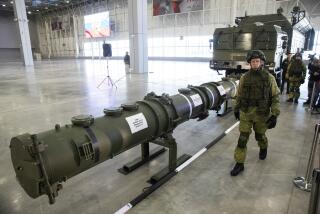U.S. Eases Demands on Soviet Missile Limits
WASHINGTON — The United States and the Soviet Union moved somewhat closer on a key issue in talks aimed at a long-range missile treaty Thursday after U.S. negotiators eased their long-held demand for strict sublimits on land-based intercontinental ballistic missiles, officials said here.
The change occurred as the United States reviewed its various positions on arms control before next week’s U.S.-Soviet summit meeting. U.S. negotiators now favor a single limit covering warheads for both submarine-launched ballistic missiles and land-based ICBMs.
The United States wants this combined limit set at 4,800 warheads, within an overall ceiling of 6,000 for all weapons. Last week at Geneva, the Soviets hinted that they might accept a 5,100-warhead ceiling, also within a 6,000 total. Thus, if Soviet leader Mikhail S. Gorbachev formally proposes the new figure next week, only 300 warheads will divide the two sides.
For years, the Pentagon had maintained that the threat of a surprise Soviet attack using ICBMs, the fastest to launch and most accurate in the Soviet arsenal, required that these weapons be restricted to a sublimit within the total limit of 6,000.
To some degree, the Pentagon still maintains this position by holding to a demand--which the Soviets are prepared to accept--of a 1,540-warhead limit on the biggest Soviet ICBM, the SS-18.
But, reflecting the new stand, Arms Control and Disarmament Agency Director Kenneth L. Adelman said Thursday that a separate land-based ICBM limit of 3,300 would be “beneficial, although not essential.”
This change of emphasis is the result of ICBMs having become a decreasing menace as submarine-launched missiles have become more accurate and powerful. Silo-based ICBMs are also giving way to mobile ICBMs mounted on trucks and railroads, which are less vulnerable to surprise attack.
Other senior officials explained that the Joint Chiefs of Staff now consider the limit of 4,800 on both ICBMs and submarine-launched missiles to be more important because it permits the Pentagon to decide how many of each type of weapon would be deployed. This will allow for a changing mixture of weapons to ensure maximum effectiveness.
Settlement of this missile sublimit issue would mark a “major advance” toward a strategic arms reduction treaty, chief U.S. negotiator Max M. Kampelman told reporters.
With those two agreements at the summit, Kampelman said, negotiators at Geneva could complete a treaty by March or April when President Reagan may go to the Soviet Union for a return summit. Both sides have said that they hope a long-range missile agreement can be signed before the middle of 1988 in Moscow.
The prospective treaty would provide reductions of about 50% in strategic offensive weapons, to 1,600 “delivery systems”--ICBMs, submarine-launched missiles and bombers--carrying a total of 6,000 warheads. But other significant difficulties still must be settled in principle before it can be completed. They include the following:
-- The Soviet demand that nuclear-tipped, sea-launched cruise missiles also be limited. The United States maintains that nuclear sea-launched weapons cannot be distinguished from sea-launched weapons with non-nuclear warheads. But it has invited the Soviets to disprove this contention. A Soviet solution may be put forward during the summit.
-- The U.S. demand that all mobile missiles be banned in the long-range agreement because their numbers cannot be verified. Again, U.S. negotiators challenged the Soviets to suggest an acceptable verification method. Whether they do or not, the Soviets are unlikely to accept the U.S. position because they recently have deployed mobile SS-25 and SS-24 ICBMs. A U.S. shift from this position is expected eventually but probably not during the summit.
--A “counting rule” for the number of warheads on missiles and of cruise missiles carried on bombers. Under past agreements, a missile was counted as carrying the maximum number of warheads with which it was tested. But most modern missiles can carry at least two more than that number and probably more, depending on their “throw weight.” Similarly, a bomber’s cruise-missile load depends on its fuel and payload capacity. New rules to reflect these realities are being sought.
In addition, the Soviets continue to insist that a long-range pact must be tied to guarantees that the United States will not deploy anti-missile defenses for 10 years. The term of such guarantees is probably negotiable but fundamental differences remain between the two sides on what kind of testing can take place during the period and what restrictions will apply when the period expires.
More to Read
Sign up for Essential California
The most important California stories and recommendations in your inbox every morning.
You may occasionally receive promotional content from the Los Angeles Times.










